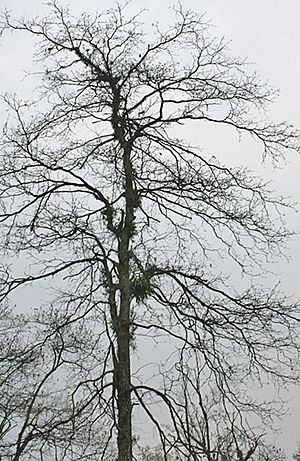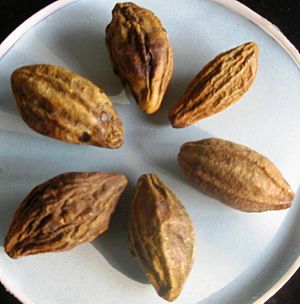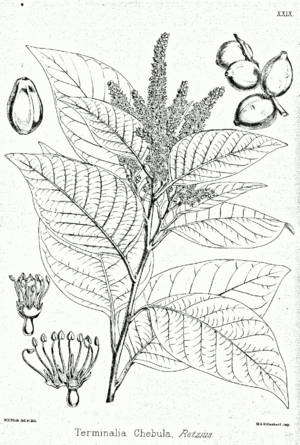Black- facts for kids
Quick facts for kids Black- |
|
|---|---|
 |
|
| A leafless T. chebula tree | |
| Scientific classification | |
| Genus: |
Terminalia
|
| Species: |
chebula
|
| Synonyms | |
Walp.
|
|
Terminalia chebula, often called black myrobalan or chebulic myrobalan, is a special tree found in parts of Asia. It grows naturally from India and Nepal all the way to southwest China, and south to Sri Lanka, Malaysia, and Vietnam. People in India know it by different names like "Harad" in Hindi and Urdu, "Kadukkai" in Tamil, and "Horitoky" in Bengali. This tree is famous for its unique fruits, which have been used for a very long time in traditional medicine.
Contents
What is Terminalia chebula?
This tree belongs to a group of plants called Terminalia. A Swedish scientist named Anders Jahan Retzius was the first to describe this specific tree. There are a few different types, or varieties, of Terminalia chebula. These varieties are mainly different in how hairy their leaves and shoots are.
- T. c. var. chebula – Its leaves and shoots are smooth, or only have hair when they are very young.
- T. c. var. tomentella – Its leaves and shoots are covered in silvery to orange hairs.
What Does the Tree Look Like?
The Terminalia chebula is a medium to large tree. It can grow up to 30 meters (about 98 feet) tall. Its trunk can be as wide as 1 meter (about 3 feet). This tree loses its leaves every year, so it's called a deciduous tree.
Leaves and Flowers
The leaves are usually oval-shaped. They are about 7 to 8 cm (2.7 to 3.1 inches) long. They are also about 4.5 to 10 cm (1.7 to 3.9 inches) wide. The leaves have a pointed tip and a heart-shaped base. They are smooth on top and a bit yellowish and fuzzy underneath.
The flowers are a dull white to yellow color. They have a strong, not-so-nice smell. These flowers grow in spikes or small clusters at the ends of branches.
The Fruit
The fruit of the Terminalia chebula tree looks like a drupe. It is about 2 to 4.5 cm (0.7 to 1.7 inches) long. It is also about 1.2 to 2.5 cm (0.4 to 0.9 inches) wide. The fruits are blackish and have five ridges running along them. When ripe, they are smooth and can be yellow to orange-brown. Each fruit has a single hard seed inside.
Where Does Terminalia chebula Grow?
You can find Terminalia chebula across many parts of South and Southeast Asia. This includes countries like India, Sri Lanka, Bhutan, and Nepal. It also grows in Bangladesh, Myanmar, Cambodia, Laos, Vietnam, Indonesia, Malaysia, Pakistan, and Thailand. In China, it grows naturally in western Yunnan. It is also grown in other Chinese provinces like Fujian and Guangdong.
In India, it is found in the Himalayan region. It grows from the Ravi River eastwards to West Bengal and Assam. It can be found at altitudes up to 1500 meters (about 4900 feet) in the Himalayas. This tree grows wild in forests in northern India. It is also common in central provinces and Bengal. You can find it in Madras, Mysore, and the southern part of the Bombay presidency. It likes dry slopes up to 900 meters (about 2950 feet) high.
How is Terminalia chebula Used?
The tree produces small, ribbed, nut-like fruits. These fruits are picked when they are still green. They can then be pickled or boiled with a little sugar. Sometimes they are used to make preserves. The seed inside the fruit is hard and covered by a firm, fleshy pulp.
There are seven main types of Terminalia chebula fruit. These types are named based on where they are harvested. Their color and shape also help tell them apart. The "vijaya" type is often preferred. This type traditionally grows in the Vindhya Range in west-central India. It has a rounder shape compared to other types.
Traditional Uses
The fruit is also used to tan leather. It can also be used to dye cloth. Terminalia chebula is a key ingredient in an Ayurvedic medicine called Triphala. Ayurveda is a very old system of medicine from India. Triphala is used for problems with kidneys and liver. The dried fruit is also used in Ayurveda for other purposes. It is thought to help with coughs and to be good for the heart. It is also used as a gentle laxative.
Natural Compounds
Terminalia chebula contains many natural compounds. These include substances like glycosides and phenolic compounds. Some of these compounds are arjunglucoside I, ellagic acid, and gallic acid. These natural chemicals are part of why the fruit has been used in traditional medicine for so long.
Gallery







